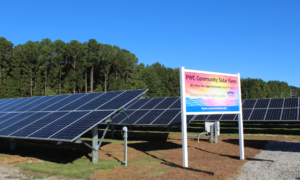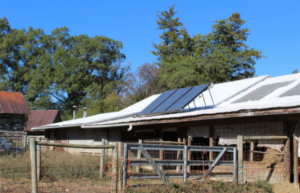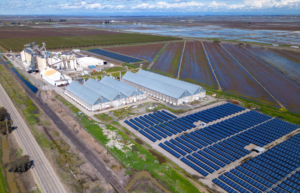Renewable Energy Development Assistance Available through the Rural Energy for America Program
The North Carolina Clean Energy Technology Center (NCCETC) is offering on-site renewable energy development assistance to agricultural producers and rural small businesses across North Carolina. The U.S. Department of Agriculture’s Rural Energy for America Program (REAP) has provided funds to NCCETC that cover renewable energy assessments and related technical assistance to eligible facilities with the intent of reducing the burden on farmers and other rural businesses to explore the viability of potentially cost-saving renewable energy.
 The NCCETC was originally founded in 1987 as the North Carolina Solar Center, highlighting our roots as a public service Center with a mission to assist residences and businesses across the state to recognize the potential benefits of solar energy. In 2014, in acknowledgement of the Center’s expanded renewable energy role and expertise in multiple technologies, our name was changed to the North Carolina Clean Energy Technology Center. The USDA funding will facilitate the application of our expertise to the energy needs of the ag and small business communities at a reduced cost.. Renewable energy offers these facilities the opportunity to reduce the energy cost burden on their operations while enhancing their energy resilience and sustainability.
The NCCETC was originally founded in 1987 as the North Carolina Solar Center, highlighting our roots as a public service Center with a mission to assist residences and businesses across the state to recognize the potential benefits of solar energy. In 2014, in acknowledgement of the Center’s expanded renewable energy role and expertise in multiple technologies, our name was changed to the North Carolina Clean Energy Technology Center. The USDA funding will facilitate the application of our expertise to the energy needs of the ag and small business communities at a reduced cost.. Renewable energy offers these facilities the opportunity to reduce the energy cost burden on their operations while enhancing their energy resilience and sustainability.
 Art Samberg, Program Director for NCCETC’s Clean Power and Industrial Efficiency Program (CPIE), is serving as the Principal Investigator for this project. The team behind the CPIE program has collectively performed dozens of renewable energy assessments for industries both large and small across the Southeast, including agricultural producers. According to Mr. Samberg, the technical reports from the renewable energy assessments that we provide can assist eligible facilities in the application to USDA for funding the implementation of the renewable energy projects. The technologies that can be funded include:
Art Samberg, Program Director for NCCETC’s Clean Power and Industrial Efficiency Program (CPIE), is serving as the Principal Investigator for this project. The team behind the CPIE program has collectively performed dozens of renewable energy assessments for industries both large and small across the Southeast, including agricultural producers. According to Mr. Samberg, the technical reports from the renewable energy assessments that we provide can assist eligible facilities in the application to USDA for funding the implementation of the renewable energy projects. The technologies that can be funded include:
- converting biomass into fuels through anaerobic digestion or other technologies to produce biodiesel and ethanol, or using biomass as a solid fuel;
- Geothermal for electric generation or direct use;
- Hydropower below 30 megawatts;
- Hydrogen;
- Wind energy generation; and
- Solar power generation.
The Inflation Reduction Act has increased funding to the USDA to further assist farmers and small businesses through REAP. The maximum grant award has doubled to $1 million. Also, while the base federal share of eligible project costs remains at 25 percent, several project categories are now eligible for up to 50 percent federal cost share. These projects include:
- Renewable energy systems or retrofits that produce zero greenhouse gas emissions at the project level;
- Projects located in an Energy Community defined in 26 U.S.C. 45 (b)(11)(B);
- Energy efficiency improvement projects; and
- Projects proposed by eligible Tribal entities.
Additionally, for FY 2023-24, grant application windows have expanded from just once per year to six (June 30, September 30, December 31,March 31, June 30, 2024 and September 30, 2024.)
Renewable Energy Development Assistance
Why renewable energy?
 Agriculture and agribusiness are North Carolina’s number one industry. A study published in 2021 by NC State University’s College of Agriculture and Life Sciences showed that over 16%, or $95.9 billion of $592 billion gross state product, is contributed by the food, fiber, and forestry industries.
Agriculture and agribusiness are North Carolina’s number one industry. A study published in 2021 by NC State University’s College of Agriculture and Life Sciences showed that over 16%, or $95.9 billion of $592 billion gross state product, is contributed by the food, fiber, and forestry industries.
Agriculture feeds the state of North Carolina, but it takes energy to sustain these critical operations. The renewable energy assistance funded by USDA through REAP aims to support the agriculture and rural small business community by providing a means to reduce operational energy costs and increase the facility’s overall resilience and sustainability. Renewable energy also contributes to an improved environment by reducing air pollutant emissions, including greenhouse gases.
“There is massive potential for agricultural operations to harness the byproducts of organic feedstocks to create the fuel to power renewable energy systems,” noted Samberg. The byproducts of the diverse farming industry in the state – whether poultry litter, swine and cattle manure, or crop residues – present opportunities for these facilities to produce biogas to offset the use of traditional fuels. This can significantly decrease operating costs, especially for smaller farms.
 To realize the true potential of renewable energy, each site needs to be evaluated to find the technology that provides the greatest opportunity for energy cost savings based on each site’s unique operations, including existing energy costs, the energy production potential at the site, the project economics and policies related to self-generation.
To realize the true potential of renewable energy, each site needs to be evaluated to find the technology that provides the greatest opportunity for energy cost savings based on each site’s unique operations, including existing energy costs, the energy production potential at the site, the project economics and policies related to self-generation.
Find Out More Information
Agricultural producers that generate 50% or more of gross income from agriculture and rural small businesses that reside in an area with a population of less than 50,000 may be eligible for renewable energy development assistance. NCCETC staff can help confirm the eligibility of your site to receive these services.
If you’re interested in learning more, visit go.ncsu.edu/REAP to find more information on eligibility criteria or contact Art Samberg at asamber@ncsu.edu to get started today.